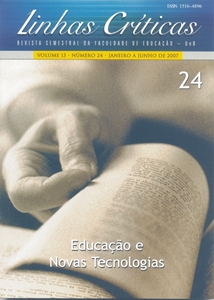Construção grupal do conhecimento por uma abordagem dialética na web
DOI:
https://doi.org/10.26512/lc.v13i24.3349Palavras-chave:
Aprendizagem colaborativa;, Lógica dialética;, Representação social;, Produção do conhecimento;, Tecnologia na educaçãoResumo
O presente trabalho discute a produção colaborativa do conhecimento na Web, provendo uma análise de como contribuições divergentes provenientes dos indivíduos tornam-se um conhecimento convergente compartilhado. Uma colaboração profícua pode desencadear a criação de algo inovador que não pode ser atribuído a nenhum aluno específico. Durante a produção colaborativa pode emergir um conhecimento que não pode ser construído individualmente. Será usada uma abordagem com base na lógica dialética, para descrever uma das possíveis maneiras pelas quais a construção do conhecimento colaborativa pode ocorrer.
Downloads
Referências
BRESLOW, Lori. Lessons learning:findings from ten formative assessments of educational initiativesat MIT. 2004.
CLARK, Herbert; BRENNAN, Susan. Grounding in communication. In: RESNICK, L. B.;LEVINE, J. M.; TEASLEY, S. D. (Eds.). Perspectives on socially shared cognition, Hyattsville, MD:American Psychological Association, 1991. p. 127-149.
DURKHEIM, Émile. The rules of sociological method. London: Macmillan, 1982.
______.As formas elementares da vida religiosa. Petrópolis: Vozes, 1996.
______. The division of labor in society. New York: The Free Press, 1947.
HEGEL, Georg Wilhelm Friedrich. Hegel: essencial writings. New York: Harper & Row Publishers, 1974.
JODELET, Denise. Représentation sociale: phénomènes, concept et théorie. In: MOSCOVICI,Serge (Org.). Psychologie Sociale. Paris: PUF, 1984. p. 357-378.
KOSCHMANN, Timothy. Dewey’s contribution to the foundations of CSCL research. ProcComputer Supported Collaborative Learning, Boulder, January 7-11, p. 17-22, 2002.
Proceedings of the international conference on computer support for collaborative learning
______; ZEMEL, Allan; CONLEE-STEVENS, Melinda; YOUNG, Nata; ROBBS, Julie;BARNHART, Amber. How do people learn? Members’ methods and communicative mediation.In: BROMME, R.; HESSE, F. W.; SPADA, H. (Eds.). Barriers and biases in computer-mediatedknowledge communication(and how they may be overcome). Amsterdam: Kluwer Academic Press.2005. p. 265-294.
KOSCHMANN, Timothy; ZEMEL, Allan; CONLEE-STEVENS, Melinda; YOUNG, Nata;ROBBS, Julie; BARNHART, Amber. Problematizing the problem: a single case analysis of a PBLmeeting. In: WASSON, B.; LUDVIGSEN, S.; HOPPE, U. (Eds.). Designing for change in net-worked learning environments: Proceedings of the international conference on computer support forcollaborative learning(CSCL '03). Amsterdam: Kluwer Academic Press, p. 37-43. 2003.
LAVE, Jean; WENGER, Etienne. Situated learning:legitimate peripheral participation. Cambridge:Cambridge University Press, 1991.
MOSCOVICI, Serge. Social influence and social change. London: Academic Press, 1976.
______. Social representations: explorations in social psychology, Cambridge, UK: Polity Press,2000.
______; HEWSTONE, M. De la science au sens commun. In: MOSCOVOCI, Serge (Ed.).Psychologie Sociale. Paris: Presses Universitaires de France, 1984. p. 211-250.
PEA, Roy. Practices of distributed intelligence and designs for education. In: SALOMON, G.(Ed.). Distributed Cognitions:Psychological and Educational Considerations. Cambridge:Cambridge University, 1993. p. 47-88.
PERKINS, David. Person Plus: a distributed view of thinking and learning. In: SALOMON, G.(Ed.). Distributed Gognitions:Psychological and Educational Considerations. Cambridge: CambridgeUniversity, 1993. p. 88-110.
PIAGET, Jean. La psychologie de l’intelligence. Paris: Armand Colin, 1967.
PILLAY, Hitendra; ELLIOT, Robert. Distributed learning: Understanding the emerging work-place knowledge. Journal of Interactive Learning Research, v. 93, n. 18, p. 93-110, 2003.
PUTAMBEKAR, Sadhana. Analyzing Collaborative Interactions: Divergence, SharedUnderstanding and Construction of Knowledge. Computers & Education, Article in Press. 2005.
STAHL, Gerry. Building Collaborative Knowing:Elements of a Social Theory of CSCL. In: STRIJBOS,J. W.; KIRSSCHNER, P.; MARTENS, R. (Eds.). What We Know about CSCL:AndImplementing it in Higher Education. p. 53-86, Boston, MA: Kluver Academic Publishers, 2004.
______. Communication and Learning in Onlinet aliilaboration. Group’03, November 9-22,Sanibel Island Florida, 2003.
______. Group Cognition in Computer Assisted Collaborative Learning. Journal of ComputerAssisted Learning, 2005.
STRIJBOS, Jan-Willem; MARTENS, Rob; JOCHEMS, Wim. Designing for Interaction: SixSteps for Designing Computer-supported Group-based Learning. Computers & Education, v. 42,p. 403-424, 2004.
SUTHERS, David. Technology Affordances for Intersubjective Learning: A thematic Agenda forCSCL. In: KOSCHMANN, T.; D. SUTHERS, D.; CHAN, W. (Eds.). Computer SupportedCollaborative Learning 2005:The Next 10 Years! Mahwah, NJ: Lawrence Erlbaum Associates;International Society of the Learning Sciences, 2005. p. 135-144.
TORRES, Patrícia; ALCÂNTARA, Paulo Roberto; IRALA, Esrom; FREITAS, Adriano. Grupos deconsenso: uma proposta de aprendizagem colaborativa para o processo de ensino-Aprendizagem.Revista Diálogo Educacional, Curitiba, v. 4, n. 13, p. 129-145, set.-dez. 2004.
VARELA, Francisco; SHEAR, Jonathan. First person methodologies: what, why, how? In:______; ______ (Eds.). The View From Within. Thoverton: Imprint Academic, 1999. p. 1-14.
VEERMAN, Arja; VELDHUIS-DIERMANSE, Else. Collaborative Learning Though ComputerMediated Communication in Academic Education. In: Euro CSCL Conference, Maastricht,Holland, 2001. p. 625-632.
VERNAUD, Grazzini. Questions vives de la psychologie du développement. Bulletin dePsychologie, Paris, v. 42, n. 390, p. 450-457, 1989.
VYGOTSKY, Liev Semionovitch. Mind in society. Harvard: Harvard University Press, 1978.
Downloads
Publicado
Como Citar
Edição
Seção
Licença
Copyright (c) 2016 Linhas Críticas

Este trabalho está licenciado sob uma licença Creative Commons Attribution 4.0 International License.
Autores que publicam nesta revista concordam com os seguintes termos:
- Autores mantém os direitos autorais e concedem à revista o direito de primeira publicação, sendo o trabalho simultaneamente licenciado sob a Creative Commons Attribution License, o que permite o compartilhamento do trabalho com reconhecimento da autoria do trabalho e publicação inicial nesta revista.
- Autores têm autorização para assumir contratos adicionais separadamente, para distribuição não-exclusiva da versão do trabalho publicada nesta revista (ex.: publicar em repositório institucional ou como capítulo de livro), com reconhecimento de autoria e publicação inicial nesta revista.
- Autores têm permissão e são estimulados a publicar e distribuir seu trabalho online (ex.: em repositórios institucionais ou na sua página pessoal) a qualquer ponto antes ou durante o processo editorial, já que isso pode gerar alterações produtivas, bem como aumentar o impacto e a citação do trabalho publicado.



